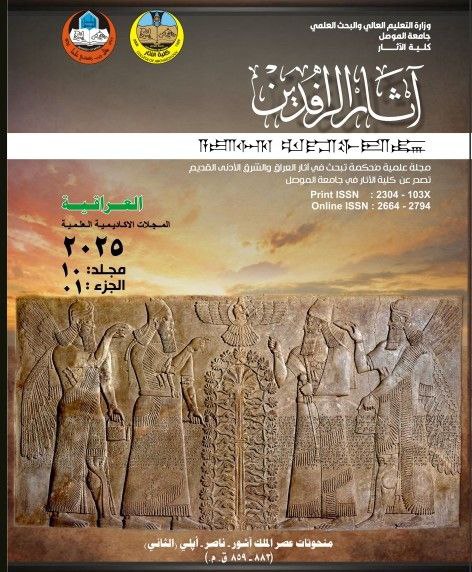Abstract
After analyzing the names of of the Assyrian queens , Iaba queen of Tukulti-āpil -Ešarra (III) (744-727 B.C.), and Baniti ,queen of Šulmanu-ašared (V) (726-722 B.C.), Atala , queen of Šarru-Ukin(II) (721-705 B.C.) , who were discovered in a beaked brick tomb under the floor of the service of wing of room 49 of the palace of Assur-nāṣir-apli (II) (881-869 B.C.) in the city of Kalhu/ Nimrud. It was found that their names of Arabic origin in term of structure and formulation. The similarity with the name of other Arab queens and kings who were contemporaries and whose named mentioned in contemporary Assyrian historical records ,such as Iapa’, Iati’ and Assyrian official Iarapa of Arabic origin. Those queens must have a relation with the Arab queens Zabibi, Shamsi , Iati’ and Adia etc.. who challenged Tukulti-āpil -Ešarra (III) and his sons Šulmanu-ašared(V) and Šarru-Ukin(II). This refute the opinions of those who tried to attribute them once to the Arameans and another time to Jews. Also the names of Ra’imâ, first queen of Šarru-Ukin(II) and Zakutu/ Naqia , the second queen of Sin – Ahhā- eriba , both of them from Arabic origin. The marriage of the Assyrian kings to these Arabic princesses and others was one of the methods of political marriages in foreign relations. This type of marriage dated back to the Middle -Assyrian period , and extended to the Neo-Assyrian period. They also married their daughters to foreign kings to gain allies and strengthen their influence over kinks and rulers outside the borders of the motherland of Assyria and to avoid further military campaigns
Keywords
Arab Queens
Assyrian
Assyrian Queens
Political intermarriage
Political Relationship
Abstract
بعد تحليل أسماء الملكات الآشوريات ياباIaba ، ملكة ُ Tukulti-āpil –Ešarra (III) /توكلتي – آبل - إيشارا (الثالث) ( ٧٤٤-٧٢٧ ق. م) ، وبانيةِ Baniti، ملكة Šulmanu-ašarid (V) / شلمانو –أشاريد (الخامس) (٧٢٦-٧٢٢ ق. م) وأتاليا Atala، ملكة Šarru-ukin (II) / شرو-اوكن (الثاني) (٧٢١-٧٠٥ ق. م) واللائي اكتشفن في قبر مبني بالأجر تحت أرضية الجناح الخدمي للغرفة ٤٩ من قصر Aššur-nāṣir-apli (II) آشور-ناصر – أبلي (الثاني) (٨٨١-٨٦٩ ق. م) في مدينة كلخو/ نمرود، تبين أن اسمائهن من أصول عربية من حيث التركيب والصياغة والشبه مع أسماء ملكات وملوك عرب اّخر عاصروهن ووردت أسماؤهم في المدونات التاريخية الآشورية المعاصرة لهن مثل، يابأ، ياتيء، يا رابأ، الموظف الآشوري من اصل عربي، وهؤلاء الملكات لابد من ان تكون لهن علاقة بالملكات العربيات زبيبي، وشمسي، و ياتيعي وعدية الخ.. ؛ اللائي عاصرن وتحدين توكلتي – آبل - إيشارا (الثالث) وابنائه شلمانو –أشاريد (الخامس) و شرو-اوكن (الثاني). وهذا يفند اراء من حاول نسبتهن مرة الى الاراميين ومرة أخرى الى اليهود. كما ان أسماء كل من رحيمة Ra’imâ ملكة شرو-اوكن (الثاني) الأولى، وزاكوتو Zakutu = نقية Naqia ملكة سين -أخي- إريبا الثانية، كلا الاسمين من أصول عربية. يعد زواج الملوك الآشوريين لهؤلاء الاميرات العربيات وغيرهن احد أساليب المصاهرات السياسية في العلاقات الخارجية ويرجع هذا النوع من المصاهرات الى العصر الآشوري الوسيط وامتد الى العصر الآشوري الحديث. كما انهم زوجوا بناتهم لملوك أجانب لكسب الحلفاء واحكام نفوذهم على الملوك والحكام خارج حدود بلاد آشور الام وتجنب مزيد من الحملات العسكرية.
Keywords
ملكات اشوريات، ملكات عربيات، زواج سياسي، علاقات سياسية، بلاد آشور
